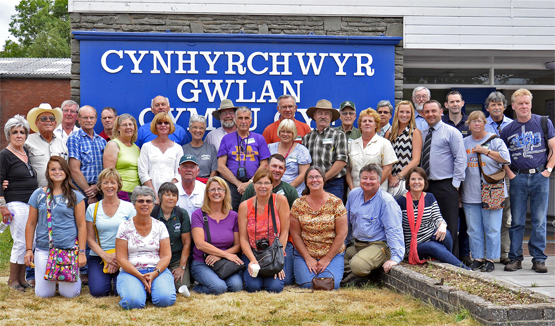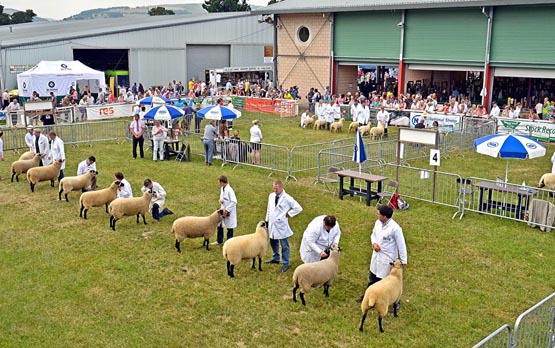After a two-year hiatus, Premier relaunched its overseas Sheep Tour program, this time visiting jolly ol’ England and Wales in July of 2013.
Thirty-five sheep producers from across the United States ventured overseas to explore England and Wales and the sheep industries therein and to have some fun along the way.
The tour began in London, where our red-eyed travelers congregated and explored the historic city. Londoners (and sympathizers worldwide) were on major “baby watch,” as the Royal Baby was due any day. Our group avoided the frenzy and managed to leave London just before the Prince was born. Some of our folks came home with souvenir newspapers from the historic day.
As our group traveled the English countryside, an abundance of quaint villages, rock walls and sheep dotted the landscape. It was quintessentially English, except for the weather. Britain’s notoriously mild summer was nowhere to be seen, and the hot sun poured down on all things great and small. Air conditioning is somewhat uncommon in English hotels, restaurants and pubs, so our group was left to sweat it out (literally) for several days and nights.
Among the noteworthy stops was a day spent at the Royal Welsh Show, one of England’s largest agricultural exhibits. When surveyed after the trip, most of the group placed the Royal Welsh Show near the top of their list. “The Royal Welsh was a highlight due to the shearing contest that was being held, all the unique breeds of sheep, and the sheep shows,” said Jim and Bonnie Davis of Illinois.
Other points of interest included a morning at the Welshpool Livestock Sale, a stop at the Brecon Wool Processing Center and a tour of the Dunbia Abattoir in Wales. Non-sheep stops included Oxford, Bath, Stonehenge, a Farmers’ Market, the “old wool” town of Cirencester, an arboretum and a day at a traditional British Game Fair.

Little Wittenham Farm, located close to Oxford, direct markets their own lamb and their farm (by charging a fees to visitors and "city" folks who wish to help them care for the sheep and land.)
The group also visited three farms in England and Wales. The first stop, Little Wittenham Farm, is located near Oxford, England. David Greene of Pennsylvania noted that “Little Wittenham Farm was an innovative marketer, taking a different approach to farming with a combination of livestock and agro-tourism.” The farm runs 1000 head of Hartline ewes and lambs, funded in part by educational school visits to the farm, an onsite shop and the sale of home-produced lamb at local Farmers’ Markets.
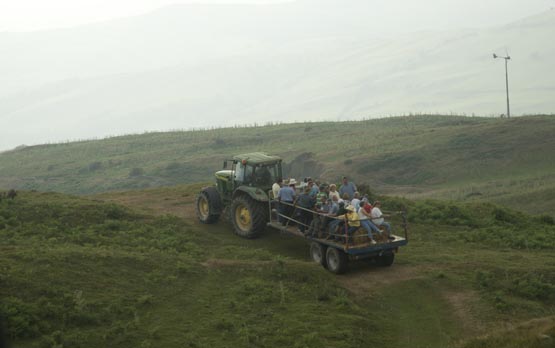
On a tour of the Evans Welsh hill farm in accessible to tour coaches. They produce very high quality lambs from land that is only marginal for fertility.
Another sheep stop, this time in the hill country of Wales, proved to be a memorable one. Farm host Will Evans and his family are located in such a remote part of the Welsh hills that the tour bus was unable to traverse their narrow driveway. So the Evans family hitched up a hay wagon to transport the group. The tractor chugged as it ascended the steep Welsh hills, but the trek afforded everyone a picturesque look at the breathtaking landscape and altitude.
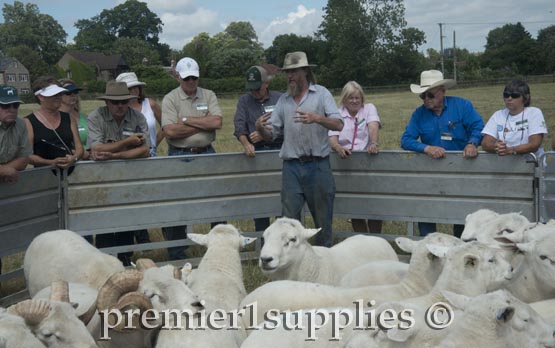
Tim White shares details on his superb Elxana ewe flock. Tim's flock is a leader in British Easy Care hair sheep. In the photo are folks from Il, WV, TX, and IA.
The third sheep stop was near Wiltshire, England, at the farm of Tim White. He grazes numerous pastures, resulting in his sheep being spread over 125 miles. Our group visited a property where Tim was grazing 200 Elxana ewes, a composite breed developed by a group of farmers in Southwest England. Minimum input and strict health and welfare standards have resulted in a disease and worm resistant wool breed that shed their fleece, eliminating the need for shearing. Tim gave a detailed presentation to our group about his flock’s genetics, methods and analysis, yearly scanning results and cull practices. For Sandra Von Allmen of New York, Tim White’s farm was her favorite sheep stop because of “his work with similarly focused shepherds for 20 years to produce a breed of sheep suitable for easy care and production.”
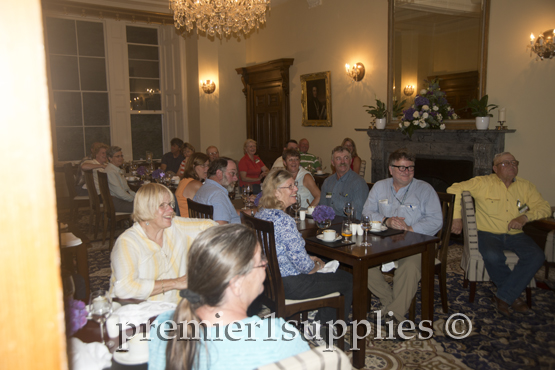
An evening meal at Nanteos Manor—a truly special hotel (mansion?) with a great history. It was head and shoulders above our expectations. If we are ever back in that area it's our choice for lodging (if we can afford it).
Throughout Premier’s past four sheep tours, there have always been standout meals and hotels. For the UK trip, the consensus was that the best meal was a lunch served at the Lakeside Golf Course in Garthmyl, Wales, where the travelers feasted on hearty portions of roast beef, gravy, Yorkshire pudding and a selection of local deserts while overlooking the River Severn. The most memorable hotel was the Nanteos Mansion, an unexpected gem tucked away near the Welsh Coast, where the group was treated like royalty by the owners and staff.
Perhaps the most important component of the trip was the camaraderie among our group of travelers, a unique and special part of every tour. “You can’t put a price on the friendships that were formed and the conversations that we had with many on the trip,” said Jim and Bonnie Davis. “This being our first trip with a group, we went away from it seeing a whole different, good perspective traveling and sharing the experience with a group.”


